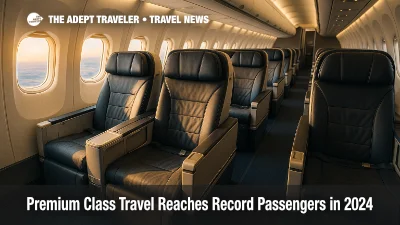Premium Class Travel Reaches Record 116.9 M Passengers in 2024

International premium cabins are no longer the preserve of a lucky few. New IATA statistics show demand for business and first class seats jumped well ahead of economy growth last year, propelled by Asia Pacific travelers and sustained corporate recovery.
Key Points
- Why it matters: Premium demand rose faster than economy, reshaping airline revenue models.
- Travel impact: Asia Pacific bookings surged 22.8 percent, lifting global averages.
- What's next: Airlines may up-gauge cabins and boost lounge capacity on key routes.
- Europe remains the largest premium market at 39.3 million passengers.
- Jeju - Seoul (CJU-GMP) overtook all other airport pairs with 13.2 million flyers.
Snapshot
IATA's World Air Transport Statistics 2024 report tallied 116.9 million international premium-class travelers, 11.8 percent more than in 2023 and equal to 6 percent of all international passengers. Global economy traffic expanded 11.5 percent over the same period. Regionally, Asia Pacific delivered the strongest premium growth at 22.8 percent, reaching 21 million customers, while Europe retained top share with 39.3 million. The Middle East posted the highest cabin-mix ratio: 14.7 percent of its international flyers paid for premium seating.
Background
The rebound in corporate travel, pent-up leisure splurges, and a shift toward "bleisure" itineraries have all supported a premium revival since borders fully reopened in early 2023. Airlines responded by restoring lie-flat capacity, reopening signature lounges, and revamping loyalty upgrades. Industry gross premium-cabin revenue recovered to 95 percent of 2019 levels in 2024, according to IATA, despite a still-uneven macroeconomic backdrop. The new WATS dataset consolidates traffic from more than 240 carriers worldwide and remains a bellwether for network planning. IATA press release
Latest Developments
Asia Pacific Leads the Premium Boom
Asia Pacific carriers carried an additional 3.9 million premium passengers year-on-year, the steepest regional gain. Growth was anchored by strong corporate demand in Japan and South Korea and rising disposable income in Southeast Asia. Analysts expect further upside once Mainland China's outbound corporate sector fully normalizes. Airlines such as All Nippon Airways and Singapore Airlines have already announced refitted wide-body cabins and new ground services to capture the surge.
Europe Holds Largest Market Share
Although its growth rate trailed Asia Pacific, Europe retained the biggest absolute volume. Business-heavy trans-Atlantic corridors, coupled with high-yield intra-European links, pushed the region to 39.3 million premium passengers. Carriers are revisiting cabin densification plans amid signs that front-cabin yields remain resilient.
Busiest Routes Shift East
Airport-pair rankings reveal a decisive pivot toward Asia. Jeju International Airport (CJU) - Gimpo International Airport (GMP) topped 2024 with 13.2 million passengers. New Chitose Airport (CTS) - Haneda Airport (HND) followed at 9.2 million, edging Fukuoka Airport (FUK) - Haneda with 9 million. Outside Asia Pacific, King Abdulaziz International Airport (JED) - King Khalid International Airport (RUH) ranked sixth at 6.3 million. North America's busiest link was John F. Kennedy International Airport (JFK) - Los Angeles International Airport (LAX) with 2.2 million travelers, underscoring the relative scale gap.
Analysis
Premium travel's outperformance signals a structural revenue opportunity for airlines. Corporate budgets, while more scrutinized, show a clear willingness to pay for flexibility and comfort when meetings matter. Leisure travelers, buoyed by accumulated savings and remote-work freedoms, are sampling front cabins in record numbers. These twin drivers reduce reliance on traditional Monday-to-Thursday business patterns, smoothing load factors across the week. For airports, higher-yield passengers boost concession spend and lounge utilization, stressing the need for upgraded premium infrastructure. Conversely, secondary hubs chasing long-haul connectivity may struggle if carriers concentrate high-margin capacity on trunk routes that already support premium demand. Environmental pressures remain a wild card; sustainable aviation fuel surcharges could offset some of the revenue gains if passed along disproportionately to premium flyers. Overall, the 2024 figures illustrate a market tilting toward quality over quantity, with Asia Pacific setting the pace.
Final Thoughts
International premium class travel now accounts for six percent of global flyers yet drives a far larger share of airline profits. With Asia Pacific growth accelerating and Europe holding strong, carriers are unlikely to trim their premium ambitions. Expect more spacious seats, refined service, and expanded lounge networks as airlines compete for this lucrative clientele in the coming year, cementing the rise of premium class travel.
Sources
- IATA launches 2024 World Air Transport Statistics report, IATA
- Premium Air Travel Sees Explosive Growth Globally, TravelPulse
- IATA releases 2024 WATS report, Airport Industry-News
- Continued APAC growth underlined by 2025 WATS data, Aviation Business News
- US leads the charge in world's busiest air routes, Travel and Tour World
